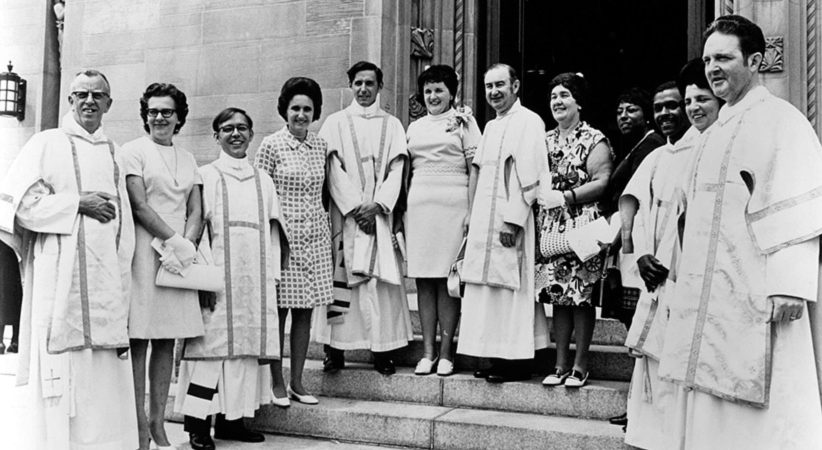An Alliterative Guide to Helpful Homilies
Tips that can make a difference in preparation, delivery and reception
Karl A. Schultz 1
For decades, it has been common knowledge at all levels of the Church that preaching and formation are lacking. Many congregants and ex-Catholics complain about not being fed, which is an article in itself. While we all are impoverished by substandard homilies and formation or hurt, and offended by uncharitable and insensitive actions (unfortunately, a fact of life in any religious community), the Eucharist still offers the bread and wine of life. And if we choose, we can lectio on the Lectionary in preparation for Mass and partially compensate for deficient preaching and formation.
Still, improved homilies would nourish all, and this is an attainable goal for deacons, no matter their background and proficiencies. In this article, following the biblical pattern of alliteration, I am going to share some concepts beginning with H and L that can make a big difference in homiletic preparation, delivery and reception.
Hustle and Help
To begin with, like prayer, reflection and study, which constitute their essence, homilies require hard work, particularly for deacons without a strong biblical background. It takes significant effort to review commentaries and ferret out the literal meaning of Lectionary passages as a foundation for applications. This presupposes that the deacon knows which commentaries are best for his purposes as well as the needs of the congregation. Again, help is available, you just need to look and ask for it.
An exegetically solid yet accessible exposition of biblical texts is becoming a lost art because of the effort and competence necessary to make the requisite substance and depth comprehensible to people at all varying levels of biblical familiarity and spiritual maturity. Deacon homilists can attain this with guidance, humble perseverance and study, without compromising their style and touch. It is an ongoing process composed of countless small steps and little victories along the Little Way.
Humanize
Our first task is to humanize both the Word and its application, and, of course, ourselves. Take seriously the humanity of the congregation, and then the Bible and its characters, especially Jesus and his parents and followers. The more we identify human values in the Bible and bring them to our lives, the better we will relate and grow in humanity.
The second task is a tricky one because it can be misapplied: Humorize the homily when appropriate. The challenge is to be pertinent, natural and fluid. Forced humor is awkward and prudence is essential because (hyper)sensitivities are rampant today.
Heavy homilies to a burdened audience can overwhelm them. Lighten things up when possible, but pedagogically, that is, with a formational and educational purpose. Rather than simply telling a joke or funny story, I recommend exposing the playfulness in the text itself with practical life issues while reminding the congregation that humor is part of the meaning and application.
Jesus’ parables and corrections/criticisms often contain implicit humor and even biting sarcasm. In hyperbolic Hebrew fashion, both Jesus and the biblical authors are apt to use exaggeration and stridency to get their point across. The intensity of the issues and people involved in both the Bible and life can be channeled, catalyzed and complemented by humor.
The homilist can lead the congregation in laughing at themselves and life. Besides refreshing and relaxing us, it breeds honesty and humility that can evoke deeper meanings and prayerfulness. Taking ourselves and life too seriously leads to scrupulosity. When a homily evokes a joyful smile and chuckle, it touches upon a healing nerve.
Hebrew Heritage
The third objective is to engage and actualize the Bible’s Hebrew modality. A simple application: Point out repetitions, connections and indicative language in the readings. Biblical authors communicate through repetition, grammar and vocabulary. The responsorial psalm typically offers provocative repetitions, vocabulary and sentiments suitable for lectio. Too often, the responsorial psalm is neglected in the homily, as well as in its presentation, despite its synchronization with the readings and its stimulation of prayer.
A companion reminder is to factor in the Ancient Near Eastern and Hellenistic contexts of the Bible and contemporary secular parallels. We live in different worlds, yet with stunning parallels in the area of cultural excesses, idolatries and temptations. Our biblical ancestors lived in environments that threatened their religious heritage and sensibilities, as do we.
The unity of the Bible is a key interpretive and homiletical theme. We should make the effort to share with congregants the parallels and connections between the readings. This highlights the genius of the Lectionary and why we should read it daily, especially in preparation for Sunday Mass. Such harmonizing does not minimize differences or contradictions. Rather, it recognizes the cohesiveness of God’s word and the way it can come together in our lives if we are receptive.
On the constructive side, be intelligible and stimulating by making your message relevant to the listener. Draw on concepts and mindsets with which they are familiar. This is not secularizing or compromising the message, but rather actualizing the context of the Bible and the Church, and making the message comprehensible to an inundated audience. Show how the Lectionary passages speak in both a timeless and time-conditioned way to today’s post-Christian milieu.
The deacon is aware of this applied, or homiletic, sense of Scripture, but the art of the homily is to synthesize it with the literal and clued/hinted/allegorical meanings. A homily that integrates these key senses of Scripture artfully and practically does justice to the source, Source and congregation.
Fifth, proceed humbly. The evangelizer begins by being evangelized, according to Pope St. Paul VI. Reform begins at home, with me. Be aware of any terminology or concepts that might be too much for the congregation and bring the message down to earth. Remember the great homilist St. Augustine’s admission that he would rather be criticized by the grammarians and understood by the people. Apply the message first to yourself, witnessing to the congregation as evidence that you are receiving the Word with them — which leads to our L guidelines.
Lectio
Lectio rather than lecture. Homilies should be the fruit of lectio and witness/testimony, rather than an exhibition of our erudition and wittiness. This article is written in a reflective, lectio style. Most of what I share is not new, but a reminder and a refinement. Read it slowly, chew on it and digest it, and pay attention to what speaks and ensues. Lectio is dialogical in nature, as ultimately homilies should be.
The focus should never be on the homilist. God and his word are front and center. Engage the word and you will engage the congregation. Get immersed in the word, and measure it against your life, and your applications and reflections will help the congregation to do the same. Open a dialogue, which is the fundamental activity of lectio, rather than talk at them. Homilists who take a story approach can deepen their interactive insights and exhortations by making the Word in all its depths and dimensions the center of their narrative.
Listen as well as draw out (the literal meaning of midrash) and weave a lesson. The latter should be an outgrowth of the former. Otherwise, we will simply project and superimpose our preconceptions, biases, theories and agendas — our homiletic hobby horses if you will. The homilist’s lectio listening lesson and especially lifestyle set an example and ambiance for the congregation.
We have to live and wrestle with our lectio lessons during the week for our message to have efficacy and staying power. We need to slow down, center ourselves, divest ourselves of burdensome attachments, distractions and superficialities, and pay attention to the divine and human signs in our life. Lectio is a dynamic lifestyle rather than a stagnant exercise. Then the peace that surpasses all understanding will be the Spirit’s gift to us as we dispose ourselves to hear the word of God and keep it (on God’s terms, not ours — always the toughest part!)
Less Can Be More
Lest we exceed the congregation’s attention span and try their patience, we must always keep in mind that less can be more in a homily. Of course, mastering this art will take a lifetime. Touch the bases, communicate the essentials, then entrust your endeavor to the Spirit and the Church.
Settle for the goal of 95% acceptable to avoid going crazy in the futile search for perfection. God is the ultimate judge and insurer of the efficacy of our efforts, so let him deal with the ambiguous and elusive remainder.
Through homiletic osmosis, let the Spirit permeate your reflections and exhortations and their implications. A homily is first what we, rather than they, need to hear and do. Consider how these H and L dynamics resonate and converge, and adapt them. Your customizations and applications can help make your homily a window on the text and the world/life that offers inspiration, meaning and guidance to a people hungry for God and his nourishment.
KARL A. SCHULTZ is an international mission and retreat facilitator on the subjects of lectio divina, theology of the body, suffering and caregiving, men’s and marital spirituality, active collaboration, St. Joseph, and the teachings and papacy of St. Paul VI. He has collaborated on DVD projects on lectio divina and marital spirituality with several bishops and theologians.
…………………………………………………………………………………………………………………………………………..
Words of Pope Paul VI
“The Church is an evangelizer, but she begins by being evangelized herself. She is the community of believers, the community of hope lived and communicated, the community of brotherly love, and she needs to listen unceasingly to what she must believe, to her reasons for hoping, to the new commandment of love.” — Evangelii Nuntiandi, No. 15
……………………………………………………………………………………………………………………………………………






Comments are closed.